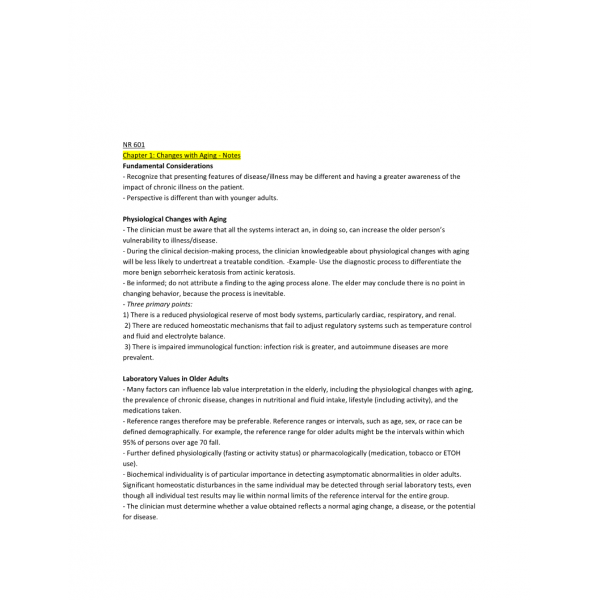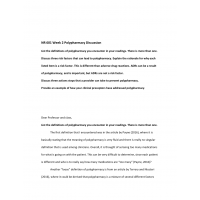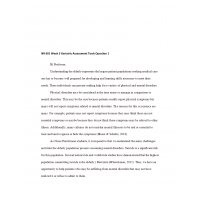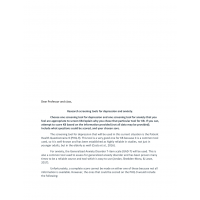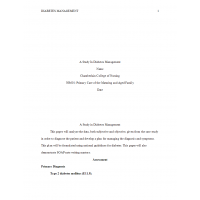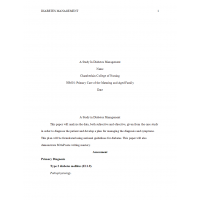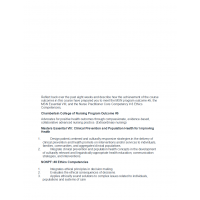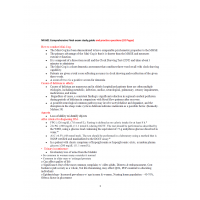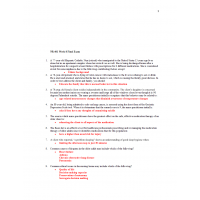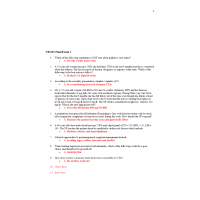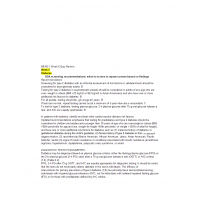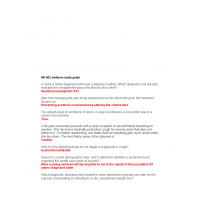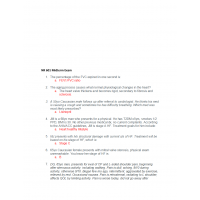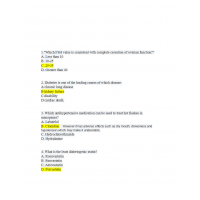NR 601
Chapter 1: Changes with Aging - Notes
Fundamental Considerations
Physiological Changes with Aging
Laboratory Values in Older Adults
Pharmacokinetic & Pharmacodynamic Changes
Absorption
Distribution
Metabolism
Elimination
Pharmacodynamics
Presenting Features of Illness & Disease In The Elderly
Chronic Illness & Functional Capacity
Chapter 1: Changes with Aging - Review Questions
1. Reference ranges or values are those intervals in which 95 % of the values fall within a specific population.
2. All of the following statements are true about renal function in the elderly except: serum creatinine is a sensitive indicator of renal impairment.
3. Of all the pharmacokinetic changes associated with aging, which is the most significant?
4. Esophageal erosions can be caused by drugs when:
5. Biotransformation of drugs primarily occurs in:
6. Changes in renal function associated with aging are most likely to result in:
7. All of the following drugs are known to be nephrotoxic except:
8. Under reporting of symptoms occurs generally when the elderly:
9. The most prevalent chronic disease in the elderly is:
Chapter 3: Exercise in Older Adults – Notes
- Americans more than 65 years now represent the most rapidly growing segment of the US population.
- These numbers will increase exponentially.
- Anticipate skyrocketing of medical costs for chronic health conditions.
- Lifestyle interventions at any age can mitigate the effects of chronic illness.
- There has been an increase in obesity in older adults, from 22% in 1994 to 38% in 2009-2010.
Available Resources
Barriers and Facilitators to Exercise for Older Adults
Patient Barriers
Patient Facilitators
Medical contraindications for Exercise Therapy
Plan for Incorporating Exercise into Patient Encounter
Key Guidelines for Safe Physical Activity (Physical Activity Guidelines Advisory Committee, 3008)
Examples of common Health Conditions in Older Adults with Exercise Recommendations
Chapter 3: Exercise in Older Adults - Questions
1) Strategies to promote increased physical activity:
2) Additional data:
3) National guidelines to consider?
4) Screening tools?
5) POC
Chapter 8: Chest Disorders - Notes
Chapter 8: Chest Disorders - Questions
1) Additional subjective information you will ask?
2) Additional objective information you will examine?
3) DDx:
4) Radiological examinations or additional diagnostic studies?
5) Treatment and prescription:
6) Potential complications from treatment:
7) Additional laboratory tests to consider?
8) Looking for a consult?
Chapter 5: Symptoms & Syndromes – CP – Notes
Etiology:
Occurrence:One of the most common causes of ER visits – 5 million/year.
Age:Risk increases with age due to CAD, HTN, lung cancer, cardiac arrhythmias, DM, recent immobilization.
Gender:Atypical presentation common in females.
Ethnicity:
Contributing factors:
Signs and symptoms:
Diagnostic tests:
DDx:
Treatment:
Follow Up:
Sequelae:A
Prevention & prophylaxis:
Referral:
Education:
Chapter 5: Signs & Symptoms – Questions
1) Additional information from history?
2) Potential contributors to constipation?
3) What physical exam is indicated?
4) Diagnostic testing?
5) Non pharmacological treatments to consider?
Chapter 2: Health Promotion – Questions
1) Risk factors for cardiovascular disease:
2) Problem list:
3) Included in primary care visit:
4) Tests & Screenings:
5) Recommended interventions:
| Institution & Term/Date | |
| Term/Date | Chamberlain University |
NR 601 Midterm Exam Study Guide
- Product Code: 2021
- Availability: In Stock
-
$25.00
Related Products
NR 601 Week 7 Reflection
$10.00
NR 601 Week 8 Final Exam 2
$35.00
NR 601 Week 8 Final Exam 1
$35.00
NR 601 Week 6 Quiz Review
$20.00
NR 601 Week 4 Midterm Exam 2
$30.00
NR 601 Week 4 Midterm Exam 1
$30.00
NR 601 Final Exam Study
$30.00

